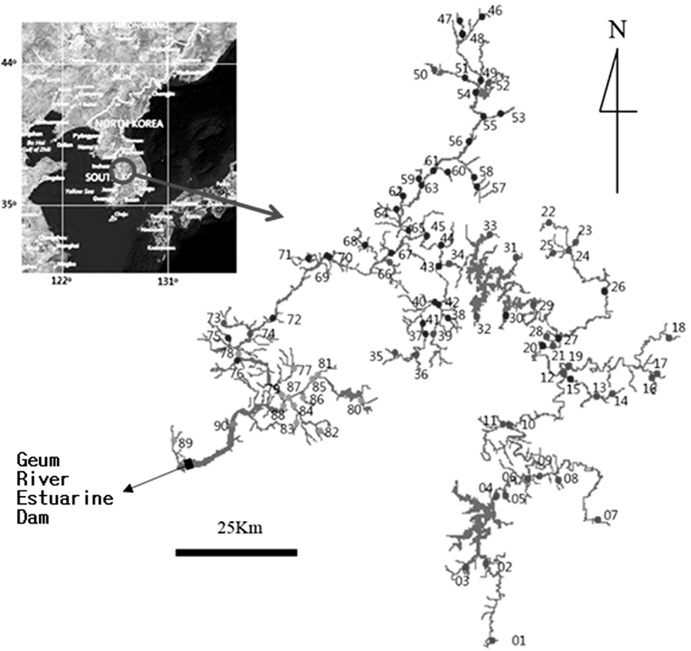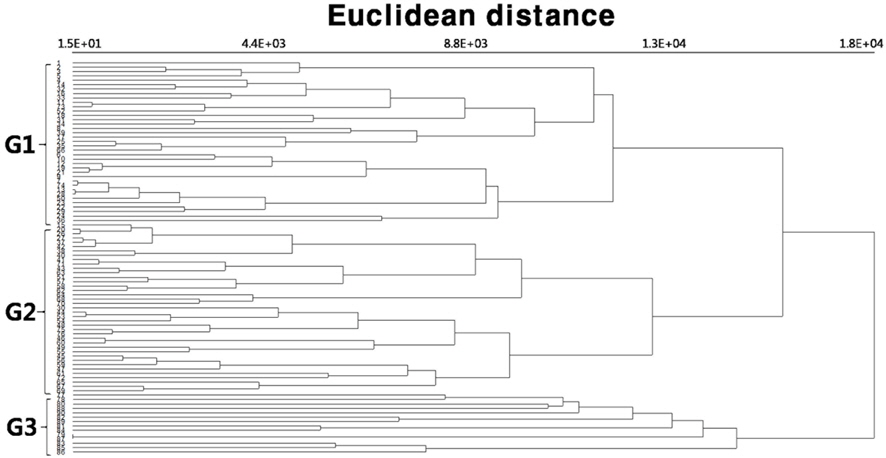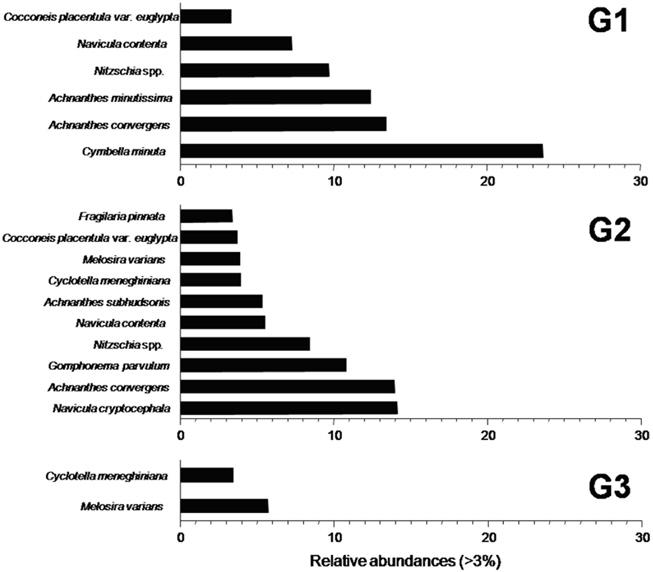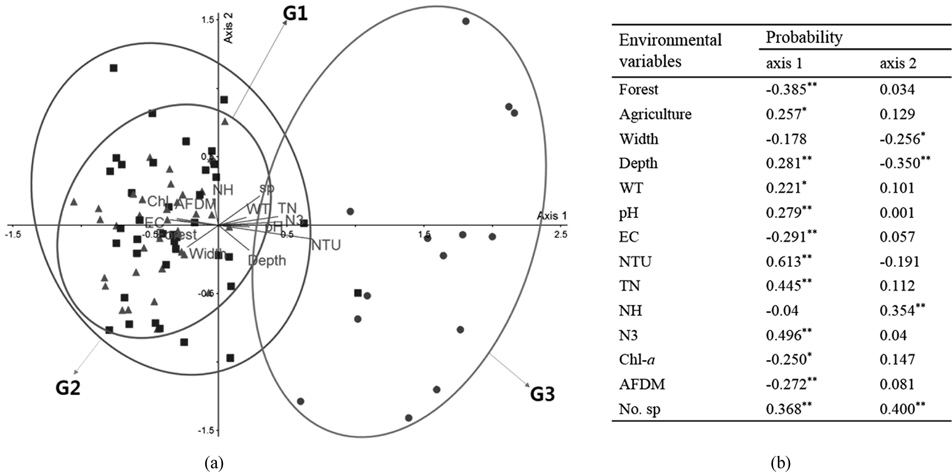


To study the distribution characteristics of diatom communities in relation to the gradient of water quality and land-use, water samples and epilithic diatoms were collected from 90 sites including mainstream and tributaries, in the Geum River System (GRS) during no rainfall, May 2011. Of 239 taxa identified,
오랫동안 인간활동은 하천이나 강에 의존되어 왔으며 따라서 하천과 이들의 배후습지를 포함한 유수계의 구조와 생태계는 항상 크게 영향을 받고 있다. 우리나라 하천은 인간의 영향이 비교적 적은 산간계류를 제외하고는 대개 도시와 농업지역을 통과하여 바다로 유입되는 이른바 산간하천, 도시하천, 농촌하천 등으로 구분된다. 일반적으로 도심지를 지나는 하천들은 도로공사, 친수환경 조성, 수변공사, 자원채취 등에 의한 구조변경 및 수질악화로 하천초기의 생태적 구조와 기능을 유지하기 어렵다(Grimm et al., 2000; Ometo et al., 2000).
금강수계는 전라북도 장수군 장수읍에서 발원하여 군산-장항을 거쳐 황해로 유입되는 우리나라 4대 하천 중의 하나이다. 유역면적은 9,885 km2, 길이 401 km에 이른다. 주요지류는 상류로부터 무주남대천, 봉황천, 초강천, 보청천, 미호천, 갑천, 유구천, 지천천, 백마강, 논산천 등이 있다. 상류역은 산간지역으로 용담댐과 대청댐 같은 다목적댐이 건설되어 있으며, 중류역에는 대도시[대전광역시(갑천)와 충주시(미호천)]와 소규모 산업시설이 집중되어 있다. 한편 하류역에는 계룡, 논산, 강경, 함열, 익산, 군산 등의 농촌형 도시와 농업지대가 자리잡고 있으며, 최하류에는 군산시와 장항군을 연결하는 하구언댐이 건설되어 있다. 금강수계는 주로 도시와 농경지(논, 밭)를 통과하므로 이로 인한 화학비료, 농약 등 농자재가 하천으로 유입되어 수질오염의 원인이 되고 있다(Han et al., 1997). 최근에는 충남 연기군, 공주시와 청원군 일부 지역에 세종특별자치시가 건설되면서 주택 및 상가건설이 활발하게 진행되고 있어 금강수계의 수질오염이 점차 증가될 것으로 예상된다(Yi, 2013).
돌말류는 지구 전체 탄소고정양의 20%를 차지하며, 강과 하천에서 미세조류 중 가장 다양한 분류군이고(Leland and Porter, 2000), 1차 생산자로서 수서곤충, 어류 등 상위인자의 먹이원으로 하천생태계의 근간을 이루고 있다(Stevenson et al., 1996). 또한 돌부착 돌말류는 암석에 장기간 부착하며, 수온, 영양염, 유속, 유량 등 환경변화에 대해 민감하게 반응하고, 다른 생물군보다 교란에 대한 회복속도가 빠르기 때문에(Allan, 1995; Bott, 1983; Hill et al., 1995) 오염 또는 환경의 상태 변화에 대해 지표생물로 사용되고 있다(Watanabe and Asai, 1990; Watanabe et al., 1990).
금강수계의 수질 및 생물조사는 비교적 활발하게 진행되어 왔으나(Han and An, 2013; Han et al., 1997; Kim et al., 1997; Na and Lee, 2011; Yi, 2013), 식물플랑크톤(Kim et al., 1996; Lee and Boo, 2000)과 부착돌말(Kim et al., 2000)에 대한 연구 등은 적었으며 조사지점 또한 제한적이었다. 따라서 본 연구는 금강수계 상류에서 하구역까지 본류와 지류를 포함한 총 90개 지점을 대상으로 하천주변의 토지이용과 수질구배에 따른 돌부착 돌말류 군집의 분포특성을 이해하기 위하여, 강우영향이 적은 2011년 봄(4~5월)에 상류에서부터 하류방향으로 2박 3일동안 집중적인 조사를 실시하였다.
각 조사지점의 돌부착 돌말류 및 환경요인 조사는 2011년 4월부터 5월 사이에 1회씩 실시하였으며, 조사지점은 금강의 본류와 지류를 포함하여 총 90개 지점을 선정하였고(Fig. 1) 기질은 수심 30~50 cm, 유속 10~50 cm/sec 여울지역에서 상부가 평편한 자갈을 채취하였다. 동시에 하폭, 수심, 토지이용도 등을 측정하였다. 토지이용도(%)는 조사지점을 중심으로 반경 1 km 범위를 농경지(agriculture), 도시(urban), 숲(forest) 등으로 구분하고 각 항목별 상대적 비율(%)을 계산하였다.
조사지점의 수온, 용존산소량, pH, 전기전도도, 탁도 등은 휴대용 수질측정기 Horiba U-50 (HORIBA Ltd., Japan)을 이용하여 현장에서 직접 측정하였다. BOD는 Winkler-azide법에 따라 현장에서 직접 채수한 시료를 300ml- BOD병에 넣고 냉암조건을 유지하면서 실험실로 운반한 후, 20℃ incubator에서 통기조건하에 5일 동안 암조건에서 배양하여 채수 당일 고정한 시료의 용존산소량을 비교하여 계산하였다(APHA, 1995). 영양염의 경우 Standard method에 의거하여 NO3-N은 Cadmium reduction법, NH3-N은 Colorimetric법, 총질소는 Cadmium reduction법, PO4-P는 Ascorbic acid법, TP는 persulfate 분해 후 Ascorbic acid법으로 각각 Spectrophotometer (SP2770i Youngwoo, Korea)를 이용하여 측정하였다(APHA, 1995).
돌부착 돌말류를 채집하기 위한 기질은 각 조사 지점에서 수심 20~30 cm 에서 최소 1주일 이상 수중에 잠겨있었고, 물의 흐름과 동일하고 상부가 고르고 넓은 자연석을 대상으로 선정하였다. 부착 돌말류를 채집하기 위해 수중에서 기질의 상부에 5×5 cm2의 고무판을 올려 고정한 후 그 외 부분을 iron brush로 제거하였다. 고무판을 누른 상태로 세척된 기질을 입구가 넓은 플라스틱 통으로 옮겨 담아 부드러운 솔과 현장수를 이용하여 기질 표면을 조심스럽게 긁어 모아 250 mL의 샘플병에 옮겨 담은 후 Lugol’s solution으로 고정하여 실험실로 운반하였다. 운반된 시료는 KMnO4를 촉매제로 이용하여 산처리(Hendey, 1974)를 한 다음 봉입제 NaphraxⓇ (Brunel Microscopes Ltd, England)를 이용하여 영구표본을 제작하였다. 돌부착 돌말류는 광학현미경(Nikon E600, Japan)을 이용하여 1000배하에서 동정 및 분류하였고, 세포밀도는 동정과정에서 표본당 출현종의 상대밀도(Relative abundance)를 구하였다. 각 기질당 최소 500개 이상의 살아있는 세포의 개체수를 S-R chamber를 이용하여 도립현미경(CKX41, Japan)에서 계수하고 여기에 각 종들의 상대빈도를 곱하여 각 출현종의 최종밀도를 계산하였다. 단 유기물을 포함하지 않은 세포는 모두 죽은 세포로 처리하여 산정에 포함시키지 않았다. 한편, 돌말군집의 특성을 파악하기 위하여 각 지점의 출현종수 및 개체수를 이용하여, 우점종 및 우점도 지수(McNaughton, 1967), 다양도 지수(Shannon and Weaner, 1948), 풍부도 지수(Margalef, 1958) 및 균등도 지수(Pielou, 1975)를 각각 산출하였으며, 군집간의 유사성을 계산하기 위하여 군집분석(Cluster analysis)을 실시하였다. 또한 군집분석에 의해 그룹화된 각 그룹간의 환경 및 생물요인간의 평균 차이를 비교하기 위하여 ANOVA를 실시하였고, 모든 과정은 SPSS software (ver. 21. SPSS Inc. Korea)를 이용하였다.
엽록소 및 유기물함량 분석은 정량 채집한 시료를 고정하지 않고 냉암조건을 유지한 채 실험실로 운반하여 실시하였다. 엽록소는 아세톤추출법에 따라 잘 흔들어준 시료의 10mL를 GF/C filter paper (Whatman Inc., England)로 여과하여 90% 아세톤으로 24시간 동안 4℃의 냉암소에서 추출한 후 원심분리기(MF80 Hanil science Inc., Korea)를 이용하여 20분간 원심분리하였다. 상등액의 흡광도는 Spectrophotometer (SP-2700i Youngwoo. Korea)를 이용하여 750 nm, 663 nm, 645 nm, 630 nm에서 측정 하였으며, 이것을 이용하여 엽록소 농도를 계산하였다(APHA, 1995). 유기물함량(Ash free dry matter, AFDM)은 시료의 10 mL를 GF/C filter paper에 여과한 후, 105℃에서 24시간 동안 건조시킨 후 측정한 무게(A1)와 이를 다시 550℃ 화로에서 1시간 동안 태운 후 측정한 무게(A2)의 차이로 계산하였다(APHA, 1995).
각 그룹별로 환경요인이 돌부착 돌말류 군집에 미치는영향을 파악하기 위하여 정준상관분석(Cannonical Correspondence Analysis)을 실시하였으며(Ter Braak, 1987), 각 axis의 통계적 유의성을 검정하기 위해 Monte-Carlo test를 실시하였다. 자료는 90개 조사지점에서 출현한 모든 종을 대상으로 하였으며, 분석을 위하여 현존량을 Log(n+1)로 변환하였다. 또한 각 군집을 대표하는 돌부착 돌말류를 선정하기 위해 지표종분석(Indicator species analysis)을 실시하였으며 지표값이 25% 이상이고 다른 그룹보다 5배 이상 높은 값을 가지는 종(good indicator)을 지표종으로 선정하였다(Dufrene and Legendre, 1997). 이들의 유의성 평가를 위해 Monte Carlo test를 실시하였다. 이상의 분석을 위해 PC-Ord Package (ver 4.25 Mjm Soft, USA)를 이용하였다.
금강수계 본류와 지류를 포함한 총 90개 지점에서 출현한 돌부착 돌말류는 총 239분류군으로 1강 2목 9과 41속 201종 33변종 2품종 3아종이었으며, 전체 우점종은 Achnanthes
각 조사지점에서 출현된 종수와 현존량(개체수)을 이용하여 cluster analysis를 실시한 결과, 13% 수준에서 크게 3개 그룹(G)으로 구분되었으며, G1은 37개 지점, G2는 39개 지점 그리고 G3는 14개 지점으로 각각 구성되어있다(Fig. 2). 각 그룹의 물리적 또는 사회지리적 특성을 보면, G1은 금강수계의 상류에 위치한 대청호와 용담호를 포함하여 주로 산간지역이었고 지류는 무주남대천, 보청천, 영동천, 초강 등이 있다. G2는 대전, 청주, 공주 등과 같은 대도시를 관통하는 중류지점으로 갑천, 유구천, 미호천 등이 유입되고 있다. 한편 G3는 논산, 강경, 서천, 군산 등의 중소도시와 농경지가 주로 집중되어 있는 하류역으로 강경천, 논산천, 노성천 등이 유입되고 있다. 결국 금강수계의 돌부착 돌말류의 분포는 비록 그룹간 조사지점수가 차이를 보였으며 예상했던 것처럼 사회지리적인 특성도 뚜렷하게 구분되었다.
각 그룹에서 출현된 돌부착 돌말류의 총 현존량의 3% 이상을 차지하는 주요 종들의 상대빈도는 다음과 같다(Fig. 3). G1에서는
각 그룹간 돌말군집 특성을 비교한 결과(Table 1), 세 그룹의 평균 밀도(현존량)는 그룹간에 유의한 차이를 보이지 않았다. 출현 종수는 G3가 G1-G2보다 (F=4.452, P=0.014), 균등도 지수는 G3가 G1-G2보다 (F=24.946, P<0.001), 우점도 지수는 반대로 G1-G2가 G3보다 각각 유의하게 높았다(F=44.465, P<0.001). 한편 다양도 지수는 G2-G3가 G1보다 유의하게 높았다(F=22.897, P<0.001). 결국, 금강수계의 돌부착 돌말류의 분포는 상류(산간하천), 중류(도시하천), 하류(농촌하천) 등으로 사회지리적 특성을 보였으나, 그룹간에 뚜렷한 현존량의 차이가 없고 군집지수 역시 상류와 하류간에만 차이가 있을 뿐, 상류-중류 또는 중류-하류간에는 유의한 차이를 보이지 않았다.

Diatom community indices (±S.E) in three groups divided by cluster analysis based on the epilithic diatom community in the Geum river in Korea from April to May 2011
각 그룹의 돌부착 돌말류 지표종을 파악하기 위하여 생물자료를 이용하여 지표종 분석(Indicator species analysis)을 실시한 결과 각 그룹을 대표하는 지표종(지표값)은 Table 3과 같다. G1에서는
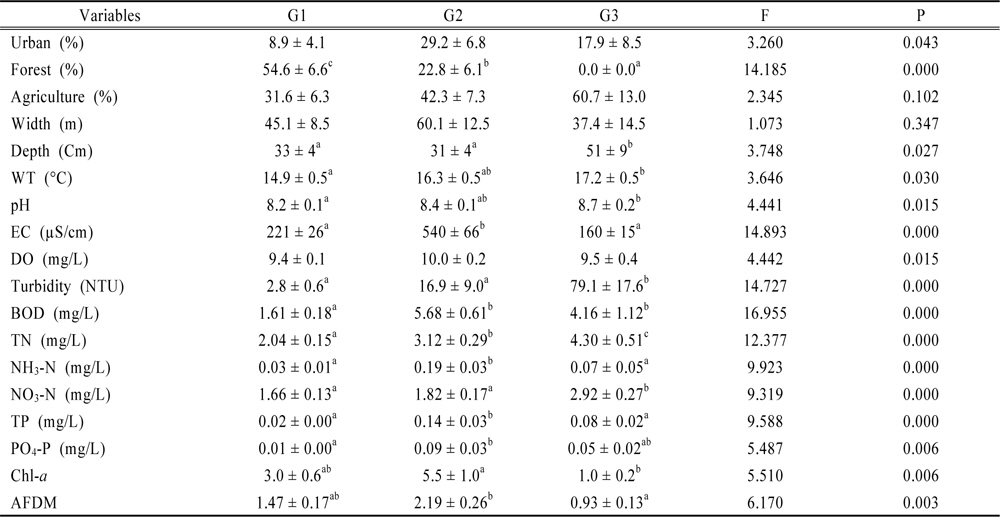
Biological and environmental variables (±SE) in the Geum river in Korea from April to May 2011
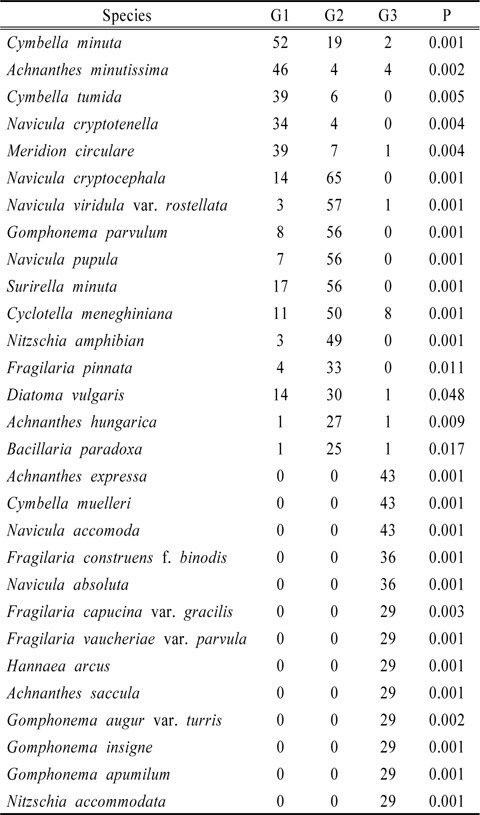
Indicator values (%) for the most important species (P < 0.05) clustered Geum river system in Korea from April to May 2011. Monte Carlo simulations (999 permutations) were used to assess the significance of each species as an indicator for each sites group
각 그룹의 토지이용도와 수질환경의 평균값을 비교하면 다음과 같다(Table 2). 토지이용도는 앞에서 언급한 바와 같이 각각 G1은 숲, G2는 도시, G3는 농경지 등이 가장 높은 비율을 차지하여 상류부터 하류까지 국내 하천의 토지이용 및 사회지리적 특성을 나타냈다. 수질환경은 G1의 경우, 세 그룹 중 BOD, TN, PO4-P 등이 가장 낮았으며 소양호(Kim et al., 2002)와 섬진강(Lee et al., 2000)의 상류와 유사한 수준으로 양호한 수질을 나타냈다. G2는 전기전도도, TP, PO4-P, Chl-
각 그룹의 환경요인이 돌부착 돌말류 군집(출현종수 및 현존량)에 미치는 영향을 파악하기 위하여 CCA를 실시한 결과(Fig. 4), 크게 두 영역으로 구분되었다. Axis2를 경계로 G1과 G2는 좌측에 위치하고(영역1), G3는 우측에 각각 위치하였다(영역2). 영역1에 대해서는 숲, 하폭, 전도도, Chl-
본 연구는 돌부착 돌말류 분포에 미치는 수환경의 영향을 파악하기 위하여 금강수계를 대상으로 조사한 것으로 출현된 부착돌말류의 종수 및 현존량을 근거로 군집분석을 하였으며, 분류된 각 cluster의 환경이 이들에게 어떤 영향을 미치는 지 CCA분석을 통해 입증한 것이다. 하지만 단 1차례의 조사결과만을 토대로 부착돌말류의 분포와 환경과의 상관 관계를 규정하는 것은 미흡한 점이 많다. 또한 조사지점 수, 수질(영양염), 물리적 환경(유속, 광도, 포식자 등)은 물론 미소서식처와 수질간의 관계 역시 부착돌말류의 분포에 큰 영향을 미친다고 판단된다. 추후 금강수계의 하천 생태계 관리 및 보존을 위하여 표준화된 부착돌말류 조사방법을 통한 보다 장기적이고 인과관계가 잘 알려진 환경요소에 대한 조사도 병행되어야 할 것으로 사료되었다.
금강수계의 돌부착 돌말류의 분포특성을 파악하기 위하여 2011년 4월~5월(갈수기) 동안 본류와 지류를 포함한 90개 지점의 토지이용, 수질 및 돌부착 돌말류 조사를 동시에 실시하여 다음과 같은 결과를 얻었다. 출현한 돌부착 돌말류는 총 239분류군으로 1강 2목 9과 41속 201종 33변종 2품종 3아종이었으며, 전체 우점종은

